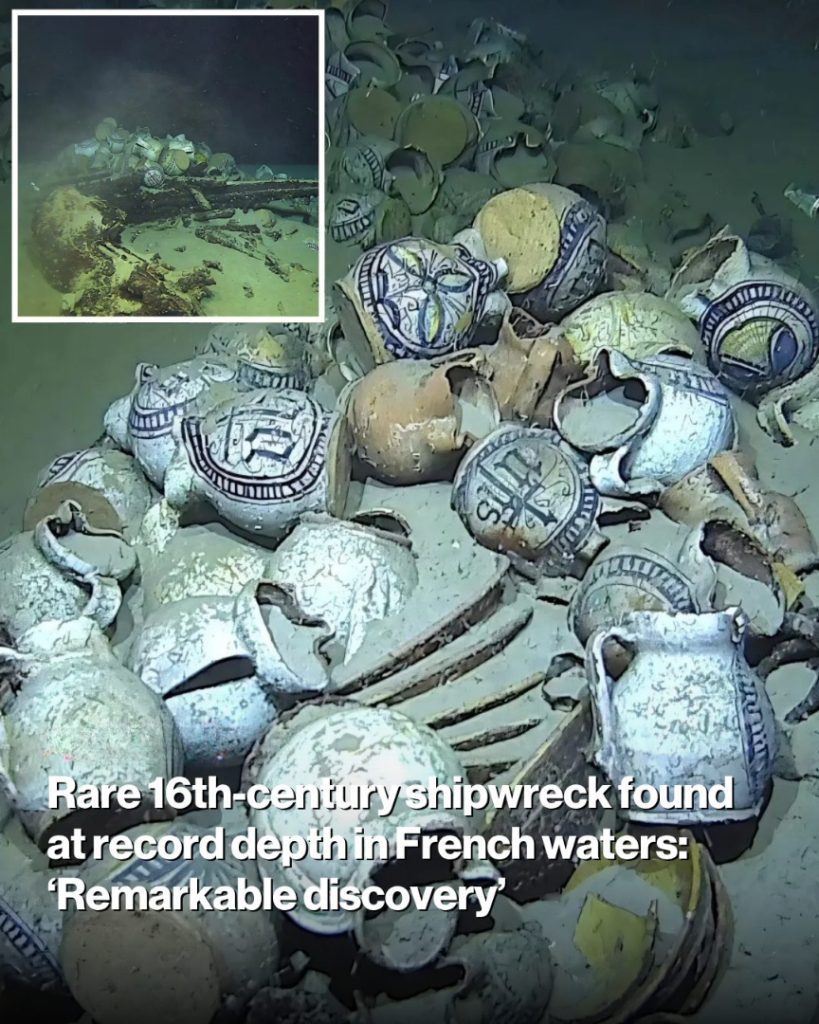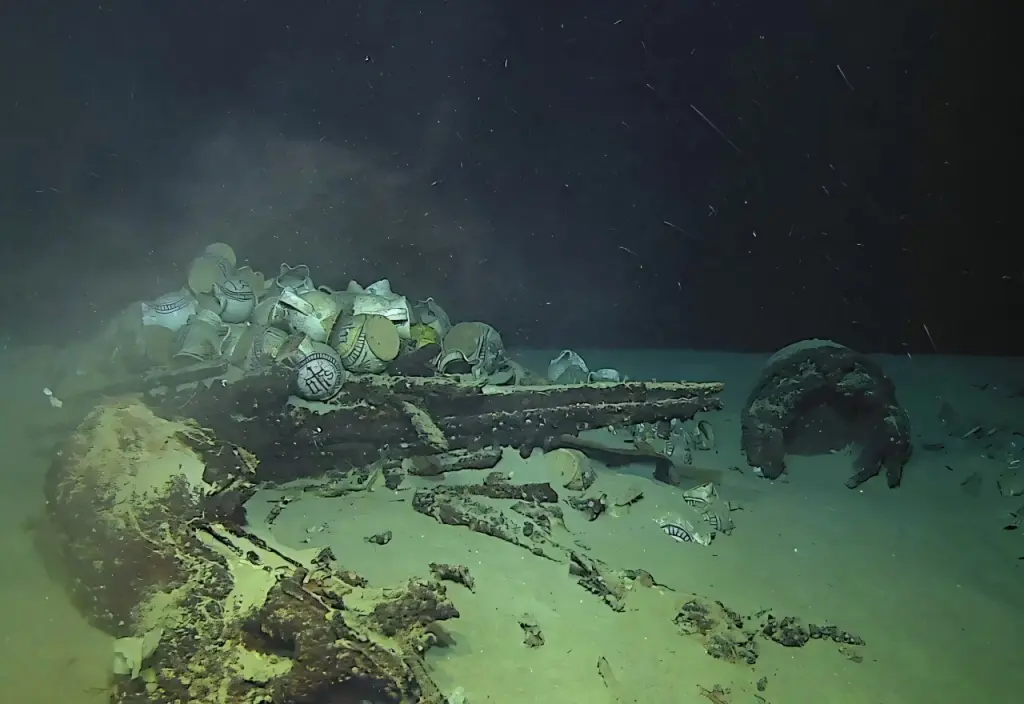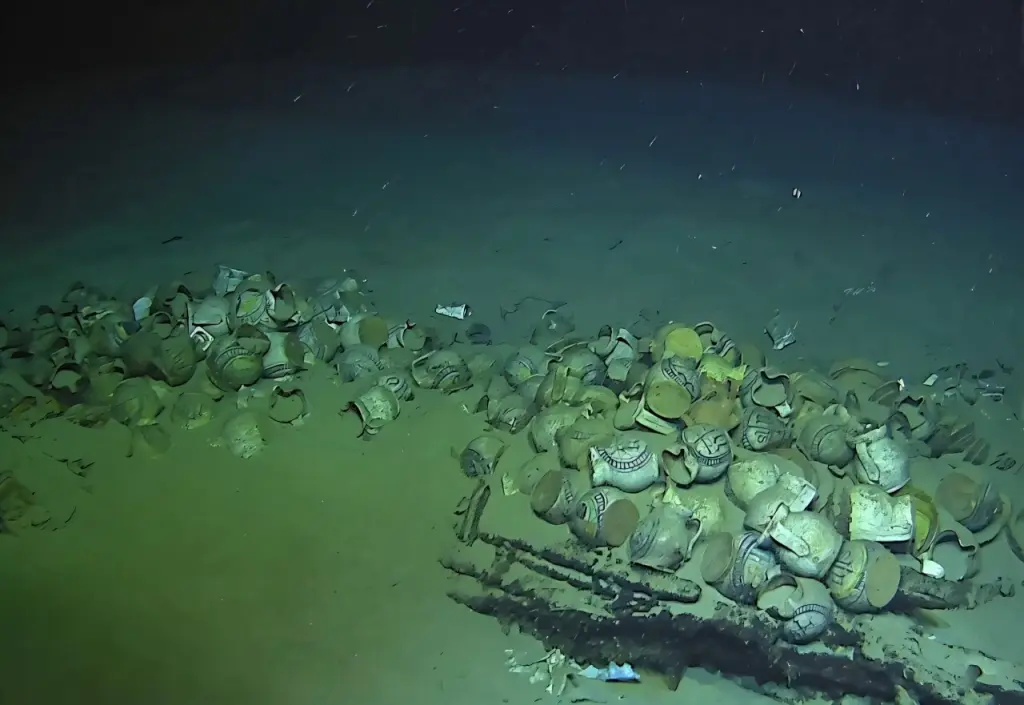A Discovery Straight Out of History Books
Imagine stumbling upon a centuries-old time capsule resting more than a mile beneath the ocean’s surface — untouched, silent, and holding secrets lost to time. That’s exactly what happened off the coast of southeastern France. On March 4, during a routine naval mission, French authorities uncovered something jaw-dropping: the deepest-recorded shipwreck in French waters. This isn’t just another underwater find — it’s a remarkable discovery that’s rewriting what we thought we knew about maritime history.
Dubbed Camarat 4, this 16th-century vessel now lies quietly on the seafloor off Ramatuelle, near the famed French Riviera. And what’s even more stunning than the ship itself? Its cargo — preserved in almost museum-quality condition — offers a breathtaking glimpse into a world long gone.

Found by Accident, Preserved by Nature
Let’s set the scene. This wasn’t some deep-sea treasure hunt. The ship was found unexpectedly by a French Navy unit during a seabed mastery operation — part of a broader defense strategy. That’s right, the find was accidental, which makes it all the more fascinating.
Sitting over one and a half miles underwater, Camarat 4 somehow managed to remain undisturbed for over five centuries. Why? The incredible depth protected it from both natural decay and human interference. No treasure hunters, no looters — just silence and sediment, keeping its secrets safe.
Video: Extraordinary 16th-century shipwreck discovered at record depth off French coast
Camarat 4: A Glimpse into the Past
Measuring approximately 30 meters long and 7 meters wide, the ship was no dinghy. It was a significant seafaring unit of its time, likely used for heavy transport across Mediterranean trade routes. But what’s inside is where things get really exciting.
Photos released by DRASSM (France’s Department of Underwater and Submarine Archaeological Research) reveal around 200 ceramic pitchers, many of them still intact. These polychrome faience vessels — that’s fancy talk for colorful glazed pottery — appear to come straight from 16th-century Liguria, a coastal region in northwestern Italy known for its pottery craftsmanship.
Relics of Religion and Renaissance Trade
The pitchers aren’t just beautiful. They’re symbolic. Many of them are adorned with the IHS Christogram — a representation of Jesus Christ commonly used in early modern Christian Europe. This little detail packs a big punch: it tells us just how central religion was in daily life, trade, and artistic design during the Renaissance.
But the ceramics aren’t alone. Archaeologists also uncovered about 100 Ligurian plates, along with anchors, cannons, and two large cooking cauldrons — strong evidence that Camarat 4 was both a merchant and a manned vessel.
Experts believe even more treasures are buried under layers of seabed sediment, waiting for future exploration. In other words, we’ve only scratched the surface.

Why This Shipwreck Is a Big Deal
Let’s put it into perspective: this isn’t just another wreck pulled from shallow coastal waters. This is the deepest shipwreck ever recorded in France’s maritime territory, and it’s from the 16th century. That’s a full hundred years before the Mayflower set sail, and just decades after Columbus’ first voyage across the Atlantic.
It’s also one of the few shipwrecks of this era to remain almost entirely untouched. Unlike other discoveries that have suffered from weathering, looting, or haphazard recovery attempts, Camarat 4 sat in quiet isolation for centuries — meaning its artifacts are pristine, the arrangement undisturbed, and the context preserved.
In the words of DRASSM, this is a “unique research opportunity” to explore a nearly intact maritime ensemble from the 1500s. For historians, that’s like finding an unopened time capsule sealed by saltwater and time.
Video: 107 Year Shipwreck Mystery Finally Solved
European Waters Are Buzzing with Discoveries
And Camarat 4 isn’t alone. European waters have become hotbeds of archaeological discovery in 2024 and 2025. Just recently:
- Off the coast of Ireland, experts uncovered what’s believed to be an 18th-century treasure ship, thought lost forever.
- In Spain, archaeologists discovered a shipwreck beneath a former fish market — yes, literally under a building — that dates back to the early modern period.
Clearly, Europe’s seafloor has stories to tell — and it’s finally beginning to speak.
Technology Makes the Impossible, Possible
Here’s something that deserves a round of applause: without modern underwater tech, none of this would be possible. The Camarat 4 wreck was discovered thanks to deep-sea imaging and remote-operated vehicles (ROVs) used during the French Navy’s operation. The crystal-clear images of the ceramics and ship’s structure prove how far underwater archaeology has come.
What used to require guesswork and blind dives now involves drones, sonar scans, and high-definition cameras — tools that let scientists study ancient history without disturbing it. It’s like taking a magnifying glass to history’s hidden chapters, one pixel at a time.

Looking Ahead: What’s Next for Camarat 4?
Don’t expect treasure hunters with diving gear to head to the wreck anytime soon. French officials have emphasized that this site is now a protected maritime cultural asset. Future exploration will likely be scientific, careful, and methodical — with teams working to catalog every artifact, every plank, every clue.
The hope? To paint a full picture of this ship’s origin, its route, its crew, and its ultimate fate. Was it caught in a storm? Sabotaged? Or did it simply vanish into the sea like so many before it? We don’t have all the answers yet — but we’re getting closer.
Conclusion
The discovery of Camarat 4 isn’t just a headline — it’s a historical revelation. This 16th-century shipwreck, found more than a mile beneath the sea near France’s Mediterranean coast, offers a rare and remarkably preserved window into Renaissance-era trade, religion, and craftsmanship.
With its untouched cargo of ceramic treasures and its mysterious silence across centuries, the wreck is a story waiting to be told. And thanks to a mix of science, luck, and deep-sea technology, that story is finally surfacing — one pitcher, one plate, one clue at a time.